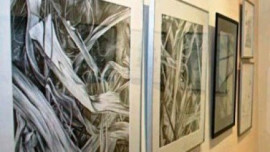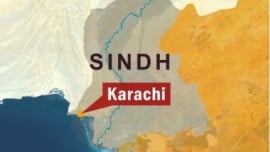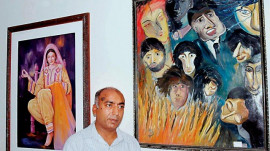
This is the second and more mature solo exhibition by Oman-based artist Sara Khan, whose last exhibited pieces in 2006 constituted a more playful and innocent exploration of her world in which more clearly defined images were visible. Art has always been an inherent and defining preoccupation for her from early childhood and time spent in the countryside has connected her definitively to the earth. The artist has been involved with the arts over the last two decades in a variety of different ways; studying Islamic Art and Architecture, working in an art gallery, attending art college, being involved with events and seminars, acting as an artist-in-residence and most recently, teaching.
A personal tragedy in 2007 was the stimulus for this current body of work. Immediately prior to this incident, Khan had been experimenting with texture and wash, inspired by a mottled green moonscape. Coming back to painting after an interval of a year and a half, she realised reflecting on her work that this was the means of expression she could use. Undertaking a looser and more abstract approach, Khan was able to use washes, layers, stains, and texture, revealing and covering over areas according to the demands of each painting. A private person, she was thus able to engage with the canvases honestly without feeling vulnerable about what was being revealed.
There is an energy and movement within these pieces, and although water, forest and stone are implied, viewers bring their own experiences to what they see. Khan’s earlier pieces indicate an intense struggle, while she mentally battled with the situation she and her family experienced. She has experimented in different ways, pitching light against a visible darkness and in some cases one can feel the willpower in the seams where the contours meet. Working her way through the paintings allowed Khan an outlet she would otherwise not have had and clarified some of the issues in her mind. Her artist’s statement hints at a semblance of acceptance, and a measure of self-empowerment, “Light cannot banish the dark, there is no easy victory, but one can always choose which way to turn”.
Stemming from distress, these pieces still convey a powerful sense of vitality and of the aesthetic. In spite of the lack of obvious imagery, the heavily textured areas create and maintain visual interest. In her 2006 exhibition, colour was an essential ingredient, and this has been developed further in the current work. Sunburnt oranges, waterfall blues and monolithic greens dominate and recede. Some combinations are harmonious whilst others such as strong reds and browns take each other head on in confrontation.
Even in the darkest paintings, Khan has consciously included slivers of relief. She feels that “it would be simplistic to label the pieces positive or negative depending on colour schemes, they are products in part of self-examination, exploration, incomprehension and gratitude, they are concrete proofs of my belief in Life.”
Published in the Express Tribune, May 30th, 2010.










































COMMENTS (1)
Comments are moderated and generally will be posted if they are on-topic and not abusive.
For more information, please see our Comments FAQ